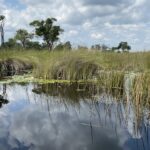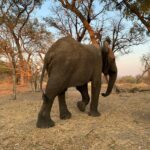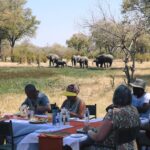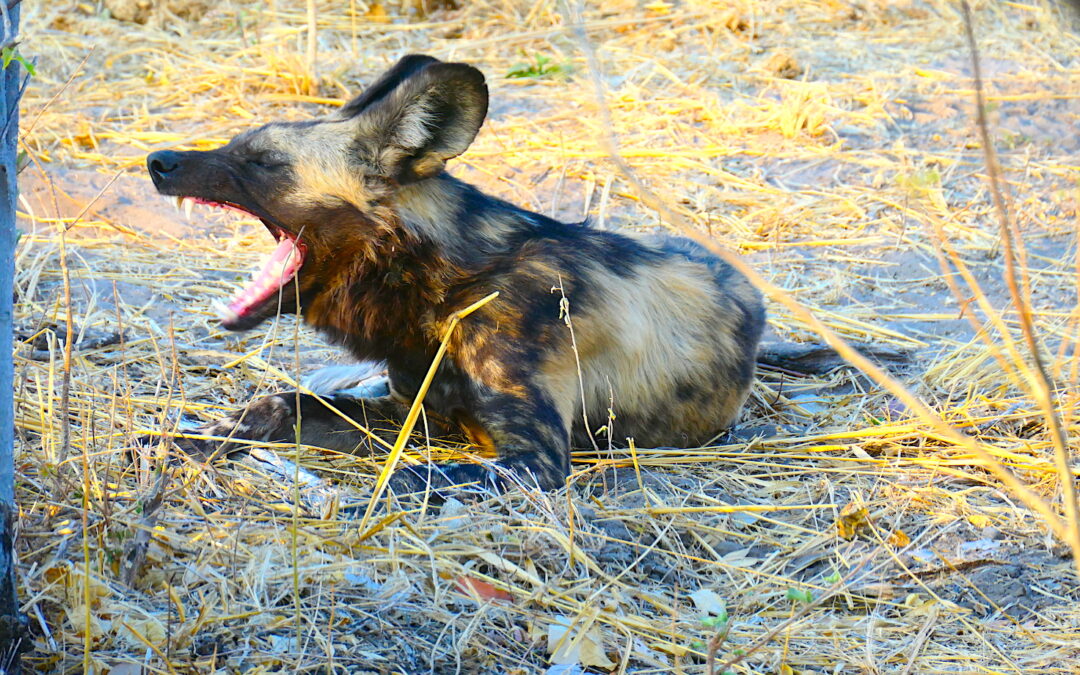
Nov 2, 2019 | Adventure Safari, Animals of Botswana, Brave Africa Safari, Game Drive
On a safari in Botswana in Brave Africa, there’s always something new to experience. We never know what we’re going to see on a game drive, but we know it’s always going to be something exciting as long as we’re open to the possibilities. This time it was a pack of wild dogs hunting.
On our most recent trip out to Xakanaxa (Moremi Game Reserve), even our staff got to join in on the excitement when at least two-dozen wild dogs, including four puppies, hunted an impala at camp.
Wild Dogs at Camp
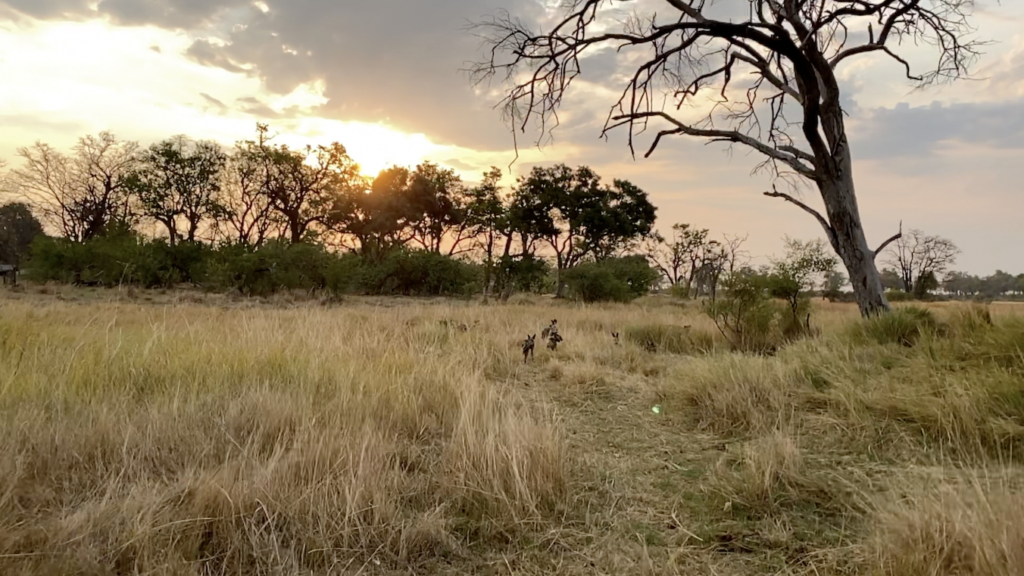
Wild dog pack of about two-dozen dogs hanging out at the Brave Africa camp in the Moremi Game Reserve.
After a wonderful all-day game drive, Wina and our guests were heading back to camp for dinner when they ran right into a huge pack of wild dogs. We were barely a hundred meters from camp. You could see the staff tents, our moving trucks, and the main tent, and yet right there in front of us, there had to be about two dozen wild dogs all walking along in the setting sun, including four puppies—around six months old.
They had just woken up from their afternoon nap and were on the hunt.
With a pack that large—more than twenty dogs—hunting enough food for everyone is a challenge. The pack has to kill multiple times a day to stay healthy, and that can be especially difficult with pups. The pups always have to be protected, but they also have to learn how to hunt, so it’s a fascinating balancing act.
When we first came upon them, the pack was slowly meandering along. They were spread out and looking for food, but nothing urgent. The pups were toward the back, bouncing along, with assigned minders to make sure they kept up and didn’t get into too much trouble. And the rest of the pack was in formation, looking for prey.
Then, between one moment and the next, everything changed.
Wild Dogs Hunt at Brave Africa
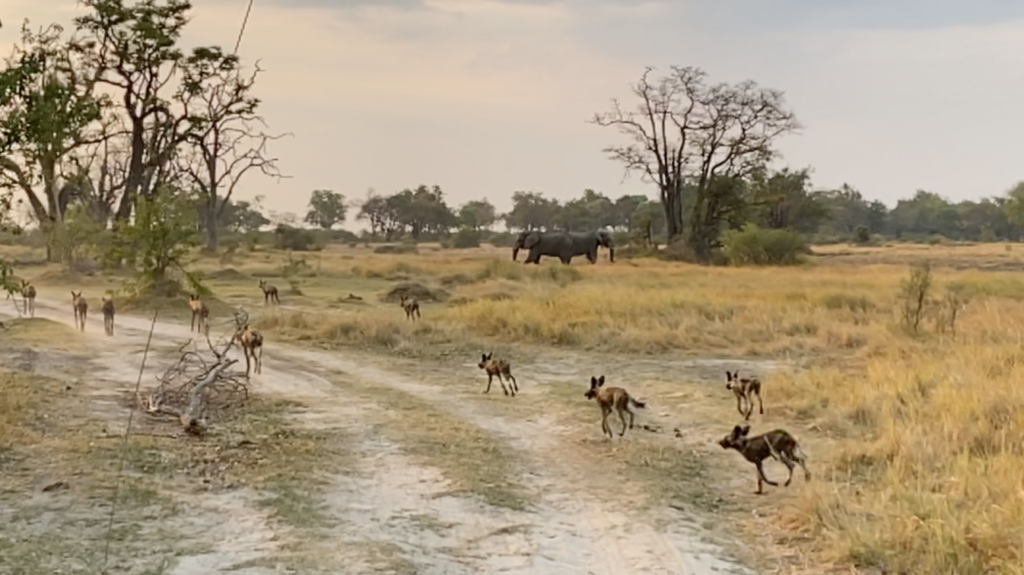
The wild dog pack prepares to hunt.
Suddenly, we heard some high-pitched squeaking. It was the dogs sending out a warning call about nearby prey. It seemed like we blinked, and then there was an impala on the move.
She was in the wrong place, at the wrong time. No lone animal would stand a chance surrounded by more than 20 hungry dogs, and neither did she. While she leaped and ran as fast as she could, she wasn’t fast enough.
The wild dogs won.
Only a few of the pack actually went to the kill site, the rest stayed back with the puppies, and so did we. The puppies didn’t have the energy to keep up with the adults on the hunt, and we didn’t have the speed, but in this case, waiting behind was not a problem.
While we didn’t witness the kill, a few minutes later, we saw something just as special.
Wild Dogs Taking Care of Puppies
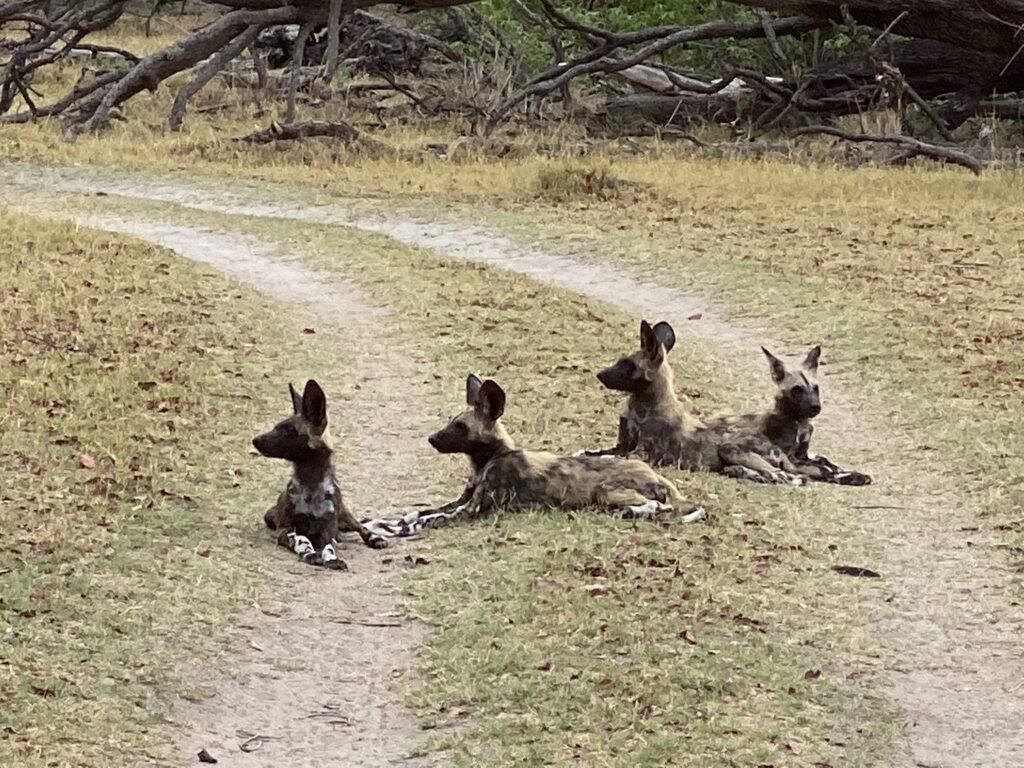
Four wild dog puppies waiting for the adults to come pack with food.
Wild dogs are incredibly social creatures. They are all about the pack. No dog is left behind, and every pup is well cared for, and we got to witness this first-hand.
Since the puppies were too young to hunt, the adults brought the kill to them. No, they didn’t drag over the kill like lions would do. They also didn’t force the puppies to move to the kill site—that would be too dangerous. Instead, the adults took turns eating and regurgitating food for the puppies.
That’s right. We got to witness wild dogs vomiting pre-chewed and swallowed food so the puppies could enjoy.
It was ADORABLE. And no, we’re not joking.

Wild dog puppies eating regurgitated impala thanks to a successful hunt.
It was astonishing to see the family dynamics. The four puppies stayed together, and every time an adult came back from the kill site, they immediately went up to the puppies and regurgitated enough for a meal.
The puppies squeaked and squealed and ate their dinner happily until the next adult would come back. They did this over and over again until the puppies were full, and the kill was demolished.
Wild Dogs and Brave Africa Staff
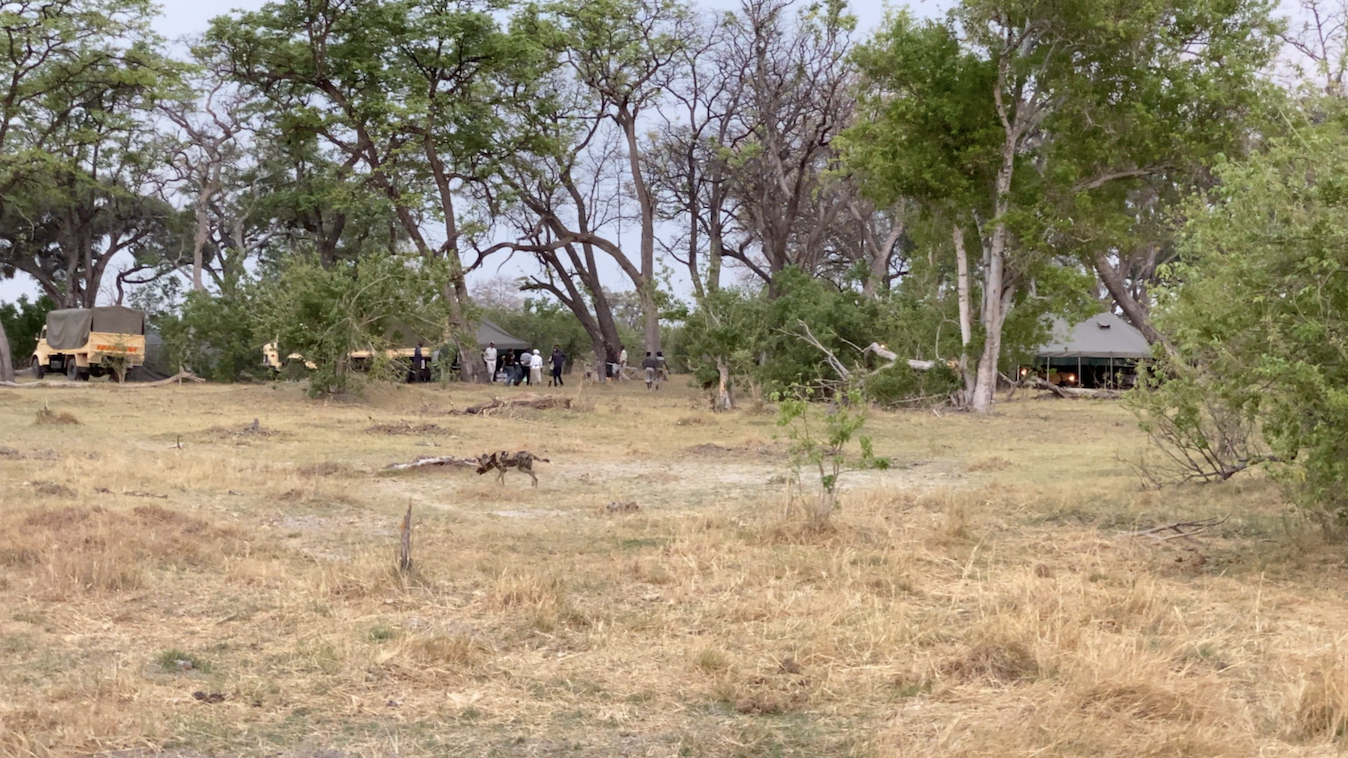
All the Brave Africa staff came out to watch the wild dogs hunt. You can see our main “mess” tent on the far right with our staff tents and moving vehicles on the left.
For some of our Brave Africa staff, it was the first time they’d ever seen a pack of wild dogs. While they’re out in the bush regularly, they mostly stay at camp. This means they’ve all seen elephants and various antelope, but predators are always rare, and they’re especially rare if you remain at camp and don’t go looking for them.
This time, the staff didn’t have to go on a game drive to experience something that is incredibly rare and exciting. All they had to do is stand at the edge of camp and watch. It was thrilling, and something we’ll be talking about for years.
Watch the wild dogs hunt for yourself!
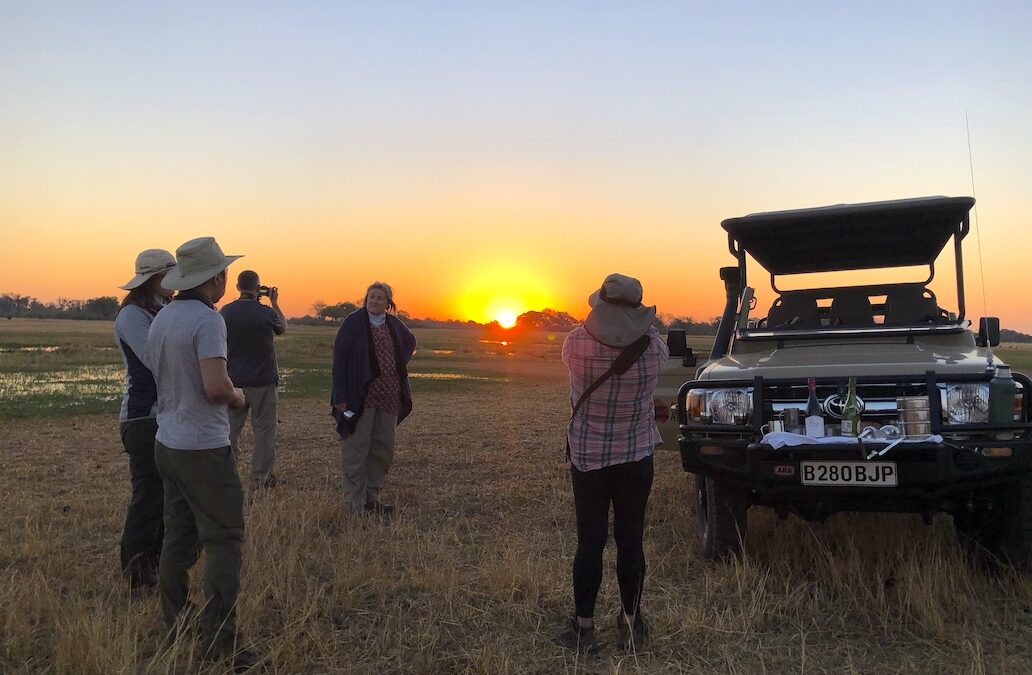
Oct 19, 2019 | Adventure Safari, Brave Africa Safari, Conservation, Most Popular Blogs
Before you decide where to go on your African safari, check out our ten reasons to go on safari in Botswana. We know you’ll love the Okavango Delta, Kalahari Desert, and Chobe National Park. Because if you’re looking for a safari that offers:
- 130,000 elephants
- Fewer crowds
- Conservation-focused tourism
- Incredible scenery
- 3,000 lions
- An adventurous experience
- Remote locations
- LGBTQ+ friendly policies
- Friendly people
- The best safari location in Africa
Look no further than Botswana! It’s truly a one-of-a-kind destination that everyone should experience.
1. 130,000 Elephants – The most of any African country
Botswana is known as “The Land of the Giants.” The country boasts 130,000 elephants, almost double the number of elephants you’ll find anywhere else in the world. This makes Botswana a haven and last refuge for these majestic creatures for the last 15 years.
What this means is that when you go on safari in Botswana, you’re almost guaranteed to see elephants every single day, multiple times a day. In fact, on our most recent trip out, we rarely had lunch without a few elephants stopping at a nearby watering hole to drink while we ate. Elephants roamed near our camp, came directly up to our safari car, and were almost everywhere we looked.
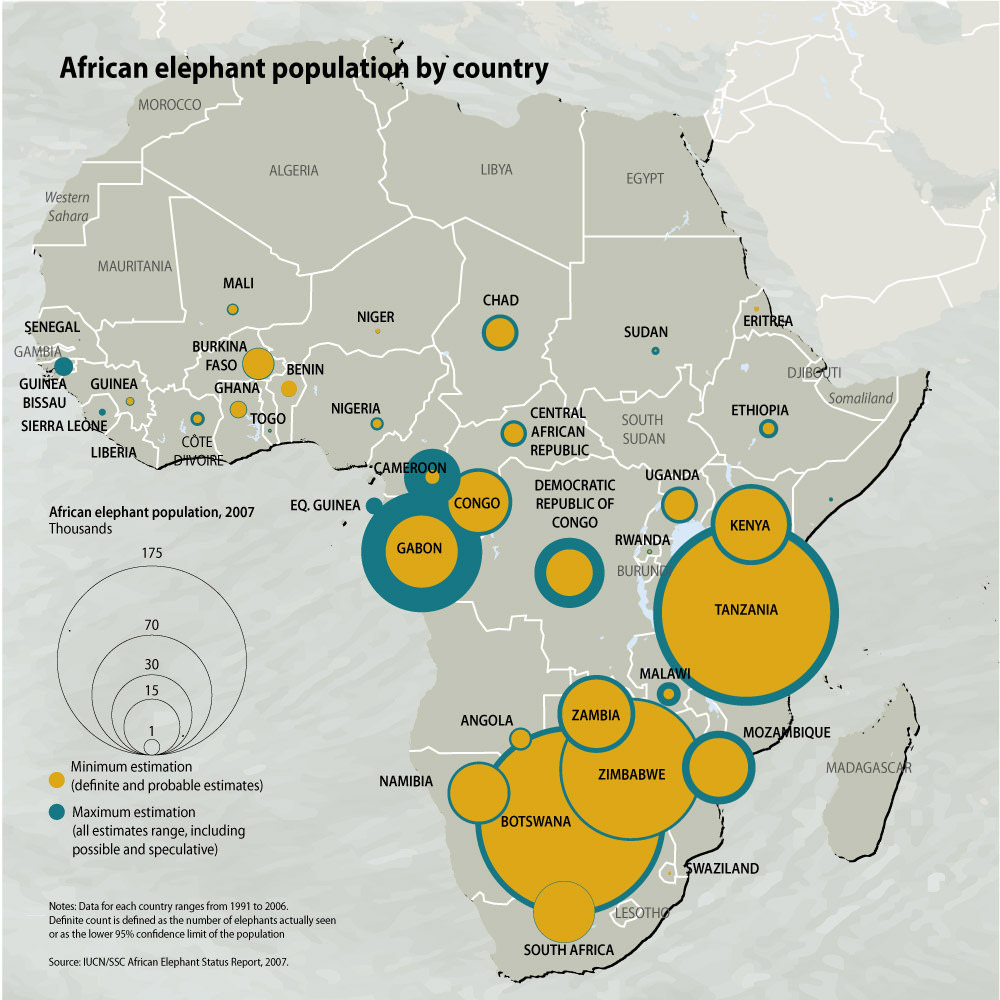
Botswana has the highest concentration of elephants by far.
2. Fewer Crowds — The experience is focused on quality, not quantity
The last thing you want when you go on safari is to be surrounded by crowds of people. After all, you’re heading to Africa to see the wildlife, not more tourists.
Botswana is considered the “road less traveled.” Fewer people think about Botswana when they consider locations for their African safari, and so there are far fewer tourists. For example, in Kenya’s Masai Mara, there are 7,000 beds available for tourists. In Botswana’s Linyanti Reserve (just outside of Savuti), there are only 58 beds in the same size area.
Botswana also has legislation in place that limits the number of tourists that can be in any single area. You won’t find as many tourists on safari in Botswana’s Okavango Delta, Chobe National Park, or the Kalahari Desert, and the camps are kept small. Most camps, including Brave Africa, max out at six tents, 12 guests. We also max out our safari vehicles at just six guests, so that every row has only two people and no middle seat.
The idea of Botswana is to have fewer crowds and more animal encounters. And isn’t that what you want?
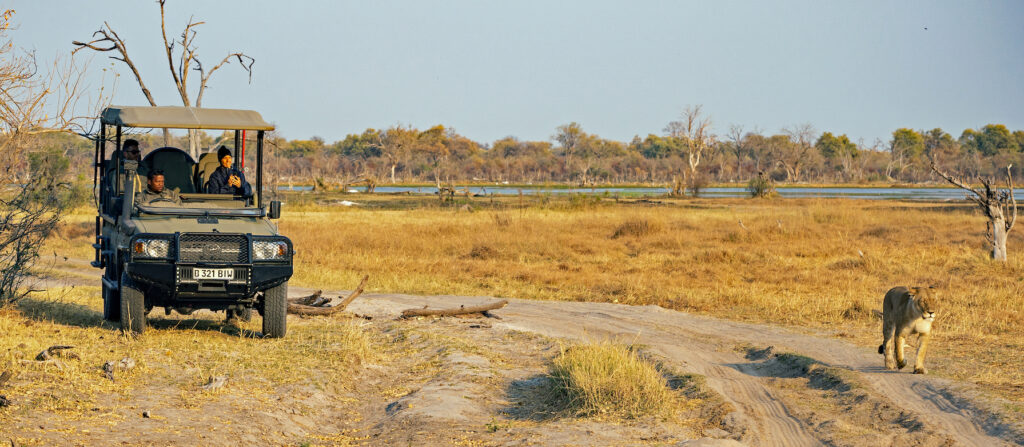
3. Conservation Focused — Botswana is ranked #1 in the world for conservation
Botswana is considered one of the last sanctuaries in Africa with untouched wilderness, making it a haven for endangered species. More than 25% of Botswana’s land area has been set aside for parks and reserves, dedicated to protecting the stunning landscapes and wildlife.
In 2017, the Lonely Planet ranked Botswana the #1 country in the world for conservation, saying, “they keep visitor numbers deliberately lower than they could so that they can manage the environmental impact of wilderness tours.”
For example, let’s take a look at rhinos. In 2001, Botswana had no rhinos left, so the country passed serious legislation focused on combatting poachers and protecting wildlife. Poaching in Botswana was punishable by death for a few years, and they are the only country to deploy the national military to keep poachers out. Today, around 400 rhinos have been reintroduced to the Okavango Delta.
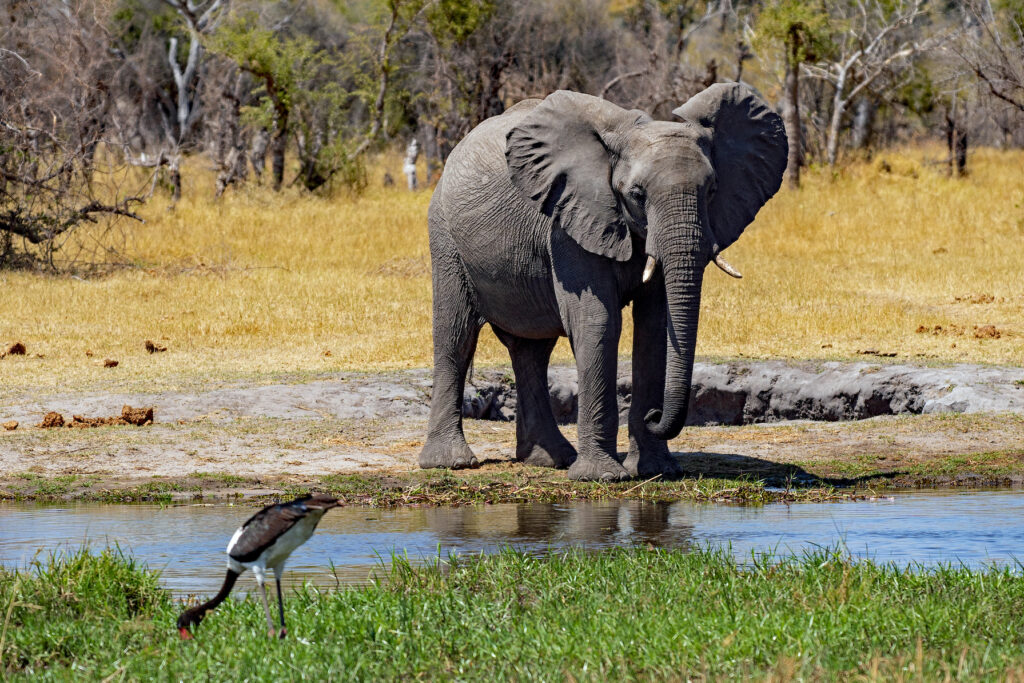
4. Incredible Scenery — Varied and stunning landscapes in the Okavango Delta, Kalahari Desert, and Chobe
Botswana is home to some of the most pristine and stunning landscapes in all of Africa. You can find a little bit of everything in the country from dusty red deserts to lush swamplands, sweeping floodplains, expansive savannahs, and vibrant forests. Honestly, during one all-day game drive, you can travel through a complete range of raw, rugged, and stunning landscapes.
In particular, the magical Okavango Delta stands out as Botswana’s main draw. It’s 16,000- square kilometers of wilderness with some of the densest wildlife in the world. The area is considered one of the largest inland water systems on the planet and home to one of Africa’s most diverse and vibrant ecosystems.
It’s a dazzling area with an abundance of lions, wild dogs, leopards, hippos, elephants, giraffe, kudu, and more. Then, there’s the Kalahari Desert that extends 900,000 square kilometers and covers much of Botswana. A semi-desert, it offers vast tracts of land that are excellent for grazing after good rains. This area is home to black-manned lions, oryx gazelle, and the incredible flamingo migration in Makagadikgadi Pans.
5. 3,000 Lions — Second only to Tanzania in lion populations
Lions can also be found throughout Botswana. In fact, after Tanzania, Botswana claims the largest population of lions in Africa. They thrive throughout the Okavango Delta, Central Kalahari, and Savuti. Best yet, lions in Botswana have some unique distinctions.
The Kalahari Desert is the only place in the world where you can see black-manned lions. These lions are known for their massive size and beautiful manes. Beyond their stunning manes, they also tend to have higher levels of testosterone, a better chance of survival, and a healthier disposition.
Then, in Savuti, there’s a pride of lions known as elephant killers. This incredible pride has learned how to take down adult elephants. While it’s not something you particularly want to witness, it makes the Savuti lions stand out for their unique hunting habits.
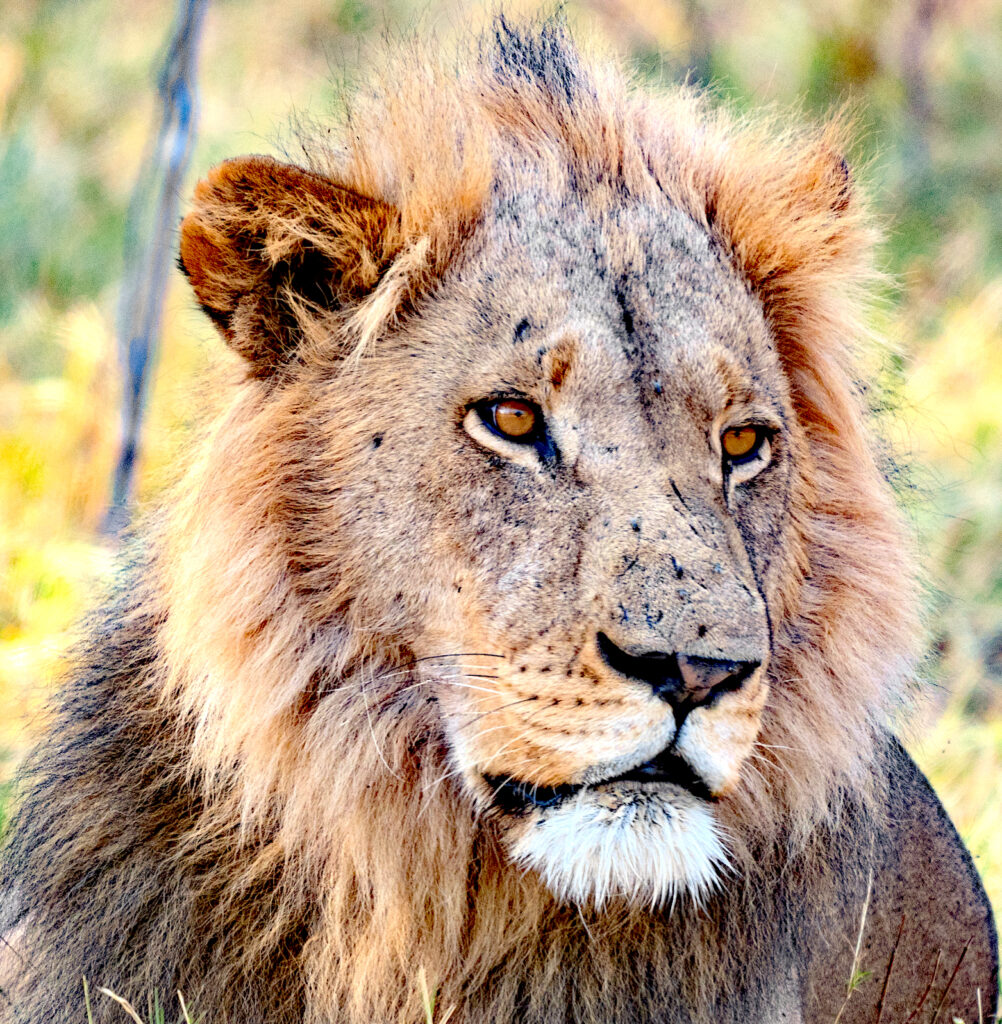
6. Adventurous Experience — Harkens back to the original safari experience
Since there are fewer tourists in Botswana, it creates a more intimate safari experience. It also translates into a much more adventurous safari that harkens back to the old days when Africa was relatively untouched by the rest of the world.
When you go on Safari in South Africa, Kenya, or Tanzania, you’ll notice that the animals tend to be very tame. Just search for videos on YouTube of cheetahs jumping on cars or a herd of zebra walking right near a car. There are so many tourists funneled through these destinations every year that the animals are desensitized. You might as well be at a zoo for all the attention the wildlife will pay to you.
That’s not the case in Botswana. Many animals in Botswana’s Okavango Delta and Kalahari Desert are still skittish around cars and people, which makes for a very different experience. It truly feels like you’re in the middle of the African Bush searching for incredible animals. Every day is an adventure, wondering what you’ll find and encounter. And because the animals are less used to humans, you always feel privileged when you have a fantastic sighting.
For example, we ran into a cheetah on our last time out that clearly did not recognize the sound of vehicles. As soon as it heard our engine, it took the cautious approach and disappeared. And while it was disappointing not to have more time with the cheetah, it was incredible to think that we may have been some of the first people to ever see him.
When you go on safari in Botswana, you feel more like an explorer, braving uncharted territory. And you feel grateful and proud of every perfect picture captured, and experience enjoyed.

7. Remote Safari Destinations — Bush planes are required to go on safari in Botswana
Part of the adventure experience in Botswana is getting to your camp. While you’ll drive most places in South Africa, Kenya, and Tanzania, Botswana requires bush planes. The Okavango Delta is massive and can swell to three times its permanent size in the rainy season. This means that driving to your remote camp isn’t feasible. Instead, you have to fly into dirt airstrips.
We think this remoteness is what makes Botswana so incredible. There are no roads near your camp, just dirt paths. A Botswana safari is truly an exclusive and immersive experience where it’s all about the wilderness.
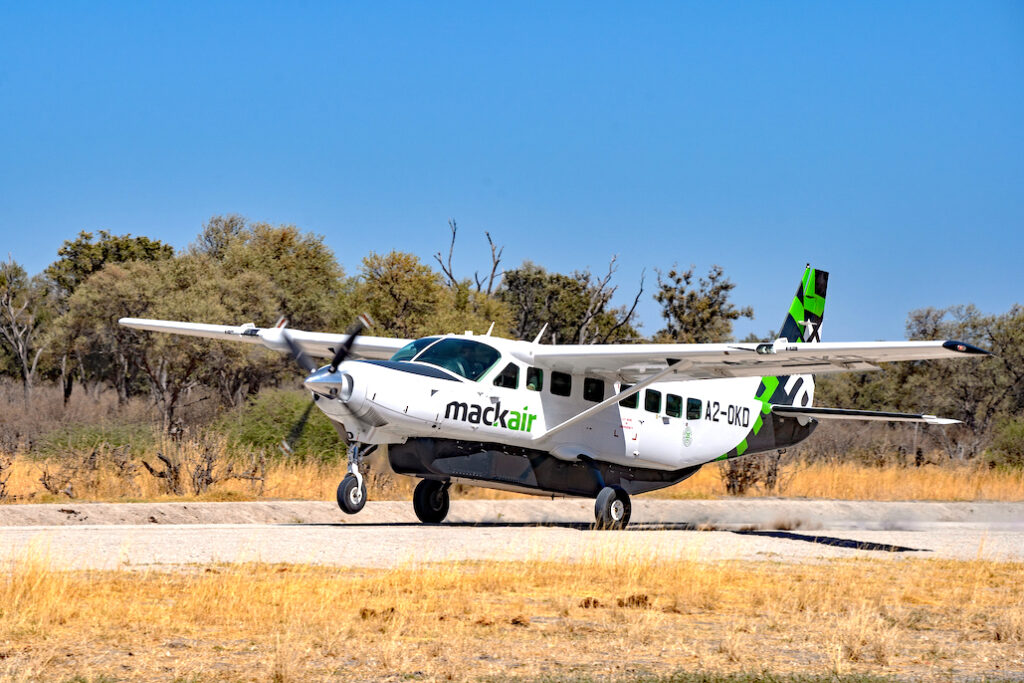
8. LGBTQ Friendly —Tolerance is promoted, and same-sex relationships are legal
This year, Botswana’s High Court unanimously voted to overturn laws that criminalize homosexuality. It was a momentous win for the LGBTQ+ community in Botswana and reflects the values of Botswana’s society.
During the ruling, Judge Michael Leburu admitted that the current laws were “discriminatory” to the LGBTQ community and violated Botswana’s constitution. He argued that overturning them was a matter of “protecting human rights.”
Botswana is actually one of Africa’s most stable democracies. In 2010, they changed their employment act to prevent discrimination against the LGBTQ community. And in 2017, the High Court ruled in favor of a transgender man who sought legal recognition as a male. 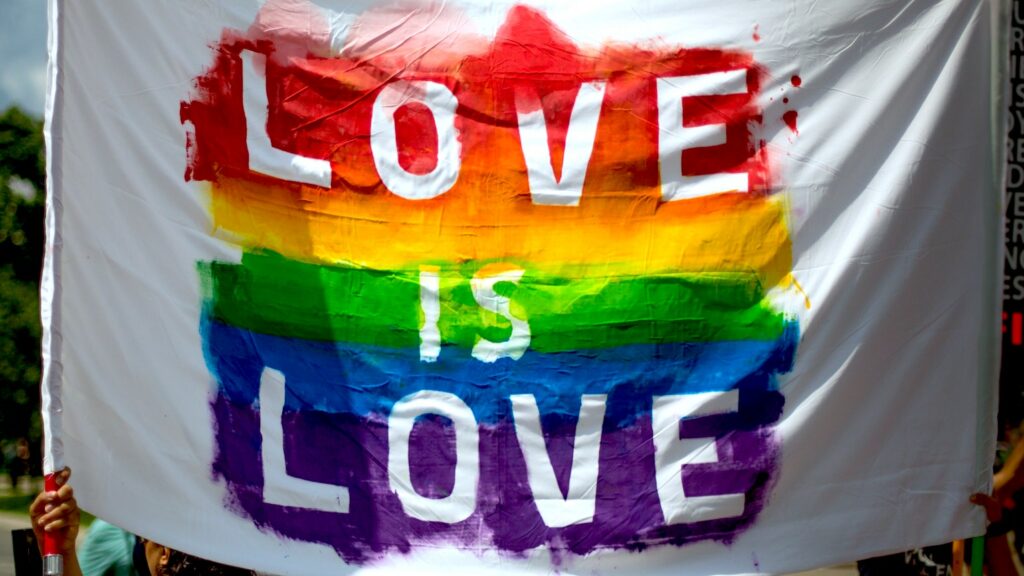
9. Friendly People —Botswanans are some of the nicest people you’ll meet
Botswana might be one of the least densely populated countries in the world, with a population of just over 2 million, but its people are the best. Botswanans are some of the friendliest and most accommodating people that you’ll meet. They take great pride in their country and in giving their best in everything they do.
You’ll be welcomed into Botswana with warm smiles and open hearts. Culturally, singing is incredibly important, so you’ll likely enjoy a song or two during your visit. You might even get to enjoy a few ululations on behalf of Botswanan women, as they show their excitement and happiness.
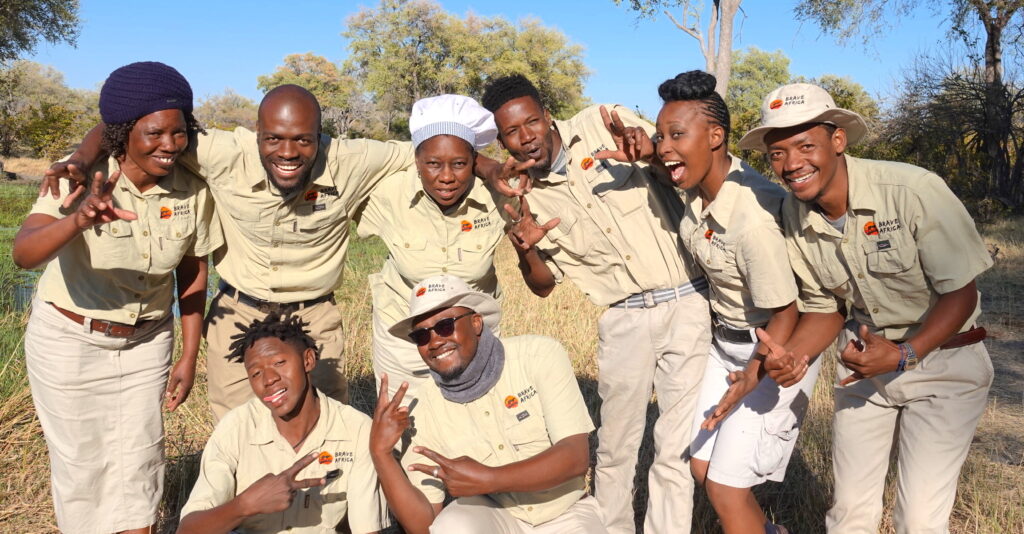
10. Best Safari Location — Botswana is regularly ranked as one of the best safari destinations
Chobe National Park is ranked as the #3 best safari destination in Africa by Fodors. It earns this prestigious title because of its incredibly dense game concentration. The area is “teeming with wildlife year-round,” Fodors writes. They also call Chobe a “stronghold of endangered species such as wild dog, cheetah, and brown hyena.” In particular, they recommend the Savuti Marsh, which we visit on our safaris.
CNN Travel recently put Botswana’s Kalahari Desert on its list of the eight best safari destinations in Africa. They write, “the Kalahari Desert represents Africa at its most brutally wild.” They highlight it as a “land of pure adventure” where you can gain insight into the diversity of Africa. They state, “there’s nothing better than a two-stop safari combining the shimmering pans of the Kalahari with Okavango wetland wilderness.”
Botswana also shows up on CNN Traveler’s “Most Beautiful Countries in the World” list. They talk about the Okavango Delta, calling it a “real-world Eden, where cheetahs, zebras, buffalo, and rhinos roam freely.”
According to Conde Nast Traveler, “Your First Safari Should Be in Botswana.” The article talks about the country’s unique tourism model that focuses on fewer people, but high spenders, so the economy grows, and there’s as little impact on the environment as possible.

Oct 9, 2019 | Adventure Safari, Behind the Scenes, Brave Africa Safari
On September 1, 2019, Brave Africa embarked on our inaugural safari. It was an incredible nine days in the bush that gave us a little bit of everything. We had a fantastic time at camp, had many once-in-a-lifetime animal sightings, and have memories that will last a lifetime. However, we also had a few things that went wrong, as every startup does.
Here’s our Botswana safari review for our first trip out. (more…)

Sep 28, 2019 | Adventure Safari, Brave Africa Safari, Game Drive, Most Popular Blogs
Out of dozens, if not hundreds, of safaris, what’s the Brave Africa difference? What makes us stand out and why should you choose to join us on your first, second, third, or hundredth safari? It’s all about our all-day safari experience compared to the traditional African safari experience!
The All-Day Safari Experience
Guests go on a Botswana safari for one reason only: to see Africa’s many amazing animals. They want to go home with incredible photos, unbelievable videos, and memories that will last a lifetime.
That’s why, at Brave Africa, our number one priority is to ensure that you have an unforgettable all-day safari experience.
To make that possible, we take our guests on all-day game drives. This increases your possibility of seeing something astonishing by keeping you out of camp and in the Bush as long as possible—after all, you have a 0% possibility of an amazing animal sighting from inside your tent.
12 to 13 hours in the Bush instead of 6 to 7 hours
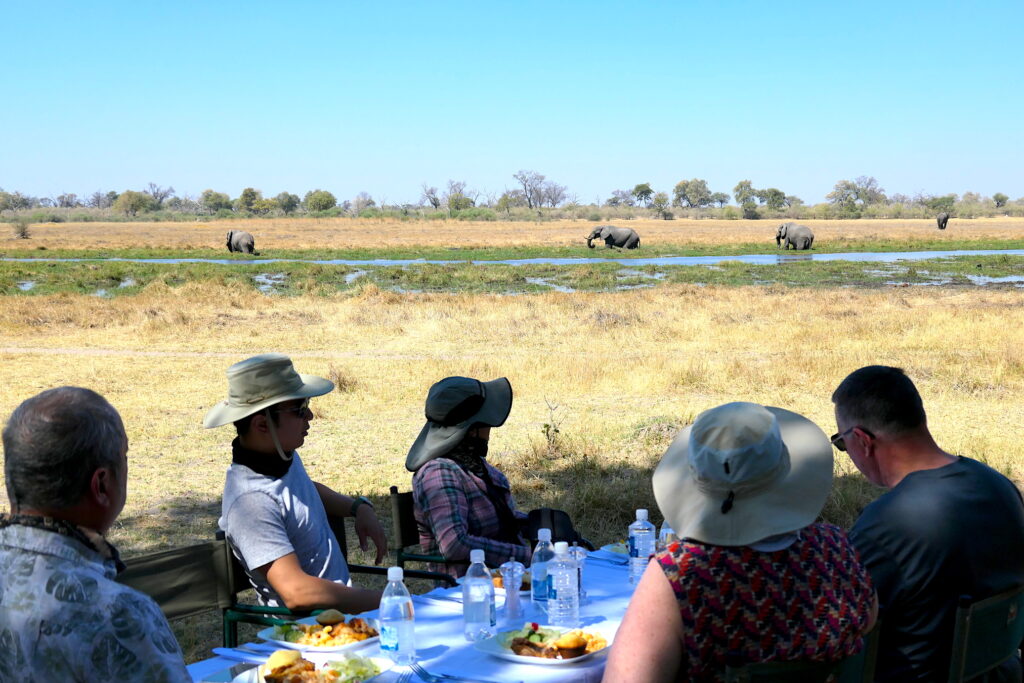
Lunch in the Bush means you get to choose amazing views like this one.
At Brave Africa, you get almost double the time in the Bush as you enjoy on a traditional safari.
On our all-day game drives, you head out of camp at sunrise—between 5:30 am and 6:30 am—and you don’t come back until sunset, or slightly after (6:00 pm – 7:00 pm). In total, you get 12 to 13 hours in the Bush every single day you’re on an all-day safari with Brave Africa.
On a traditional African safari, you have 3 to 4 hours on your morning game drive—from sunrise until around 10:00 am. After that, you’re back at camp for almost 6 hours for lunch and an afternoon nap. Then, you’re finally back out in the Bush at 4:00 pm until sunset for another 2 to 3 hours on a game drive.
That’s just 6 to 7 hours in the Bush with the other 6 hours spent at camp.
Cover more ground instead of being stuck near camp.
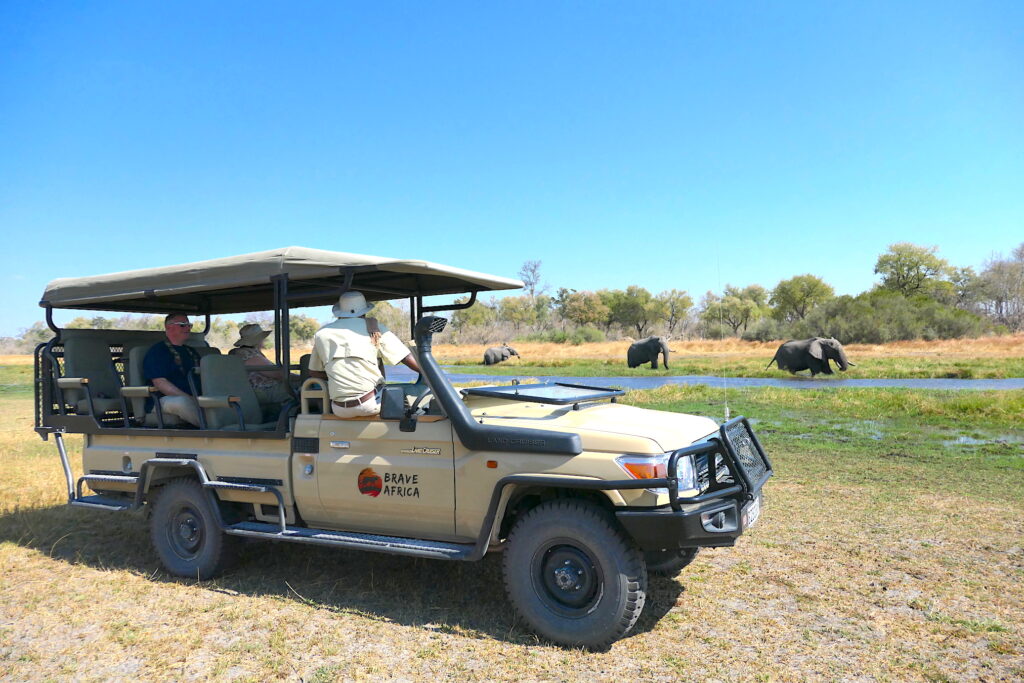
Your Brave Africa safari vehicle can travel almost 6 hours in one direction before having to turn around, which means you can really explore the bush.
Being out on our all-day game drives also means that your Brave Africa car can travel long distances. Since we don’t have to be back at camp until evening, we can really explore the area, following the animals where they go or even just to enjoy a change of scenery.
However, because traditional safaris require you to be back at camp within a few hours, your area of travel is highly limited. You can’t explore too far from your home base or you won’t make it back for lunch.
A pace you control instead of a set schedule.
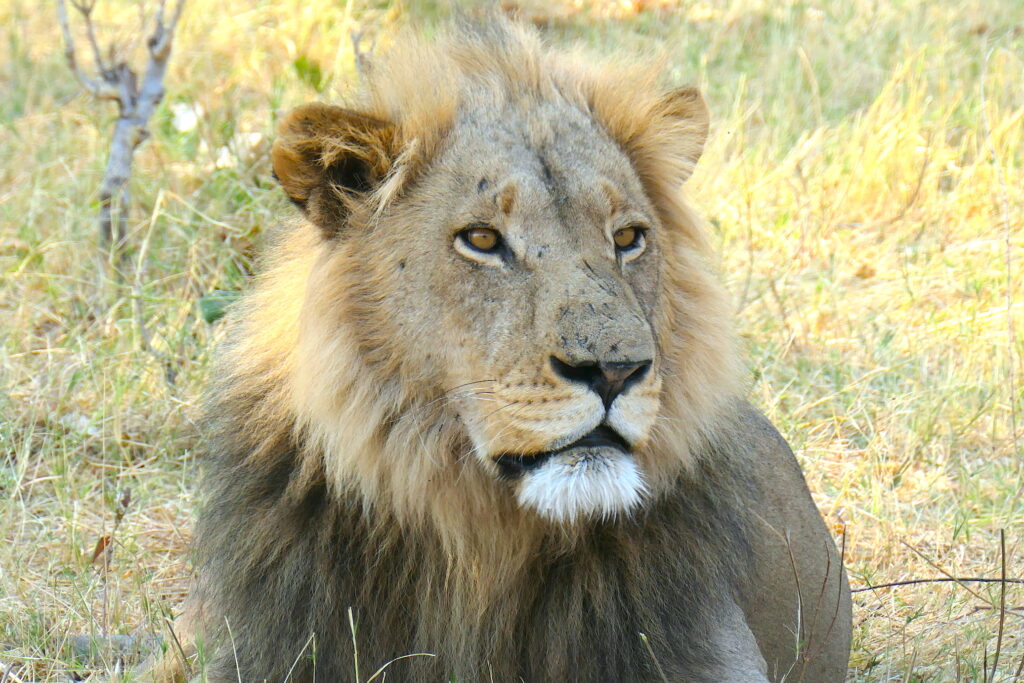
If you are enjoying an incredible sighting of a male lion, you don’t have to leave because you’re on a schedule. You can stay as long as you want.
Twelve to 13 hours in the Bush every day doesn’t mean you never have a chance to breathe or relax. Instead, it means the Bush and the animals help decide your day instead of trying to force nature to conform to our schedule.
So, if your game drive is really packed full of animals, you can put off your rest times until there’s a natural break. However, if the day is slow, you can rest early and give more time to your afternoon. Whenever you’re ready for a break, your guide will find a gorgeous spot in the bush—under some shade—where you can rest, relax, eat, drink, and enjoy the beautiful scenery.
On a traditional African safari, your day is scheduled for you. Yes, if you have an incredible sighting you can stay out longer, but there is always time pressure to get back to camp for lunch. Your schedule is controlled by the camp and not by nature, which can make you feel a little more like you’re in a theme park instead of on a Botswana safari.
Why Do You Want All-Day Game Drives?
So, why are all-day game drives what you want when you go on safari?
- Sometimes during the heat of the day—from 10 am until 3 pm—is the best time to see animals. It was during these hours that on one all-day game drive our guests and team ran into a cheetah hanging out and watching some warthogs.
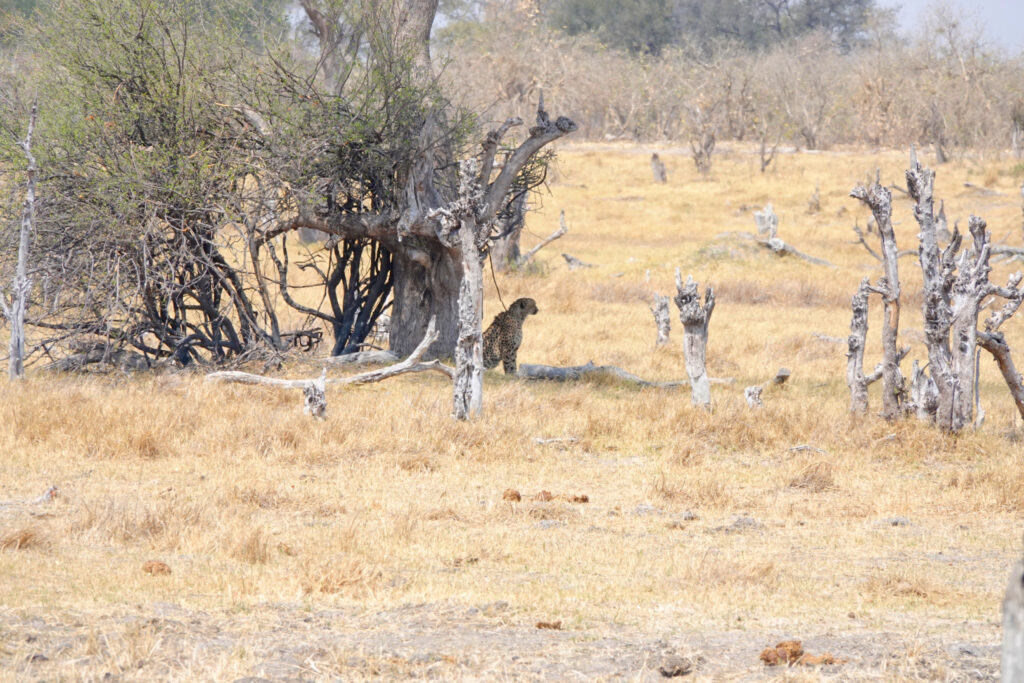
We saw this cheetah around 1 pm during an all-day game drive.
- Botswana is a desert. It’s HOT, especially in the middle of the day. It can easily reach over 40 degrees (C)—over 100 degrees (F)—and that’s hot no matter who you are or where you’re from. Would you rather be roasting in your tent in the middle of the day—few if any camps or lodges in the Bush offer air conditioning in your tent? Or would you rather enjoy the natural air conditioning offered by a moving, open-air vehicle and the chance to see incredible animals?
- A Botswana safari is not cheap. If you’re paying thousands of dollars do you want to pay for an all-day safari or a traditional African safari where you spend half of your time back at camp? You’re basically paying to take a nap instead of paying to spend time with the animals.
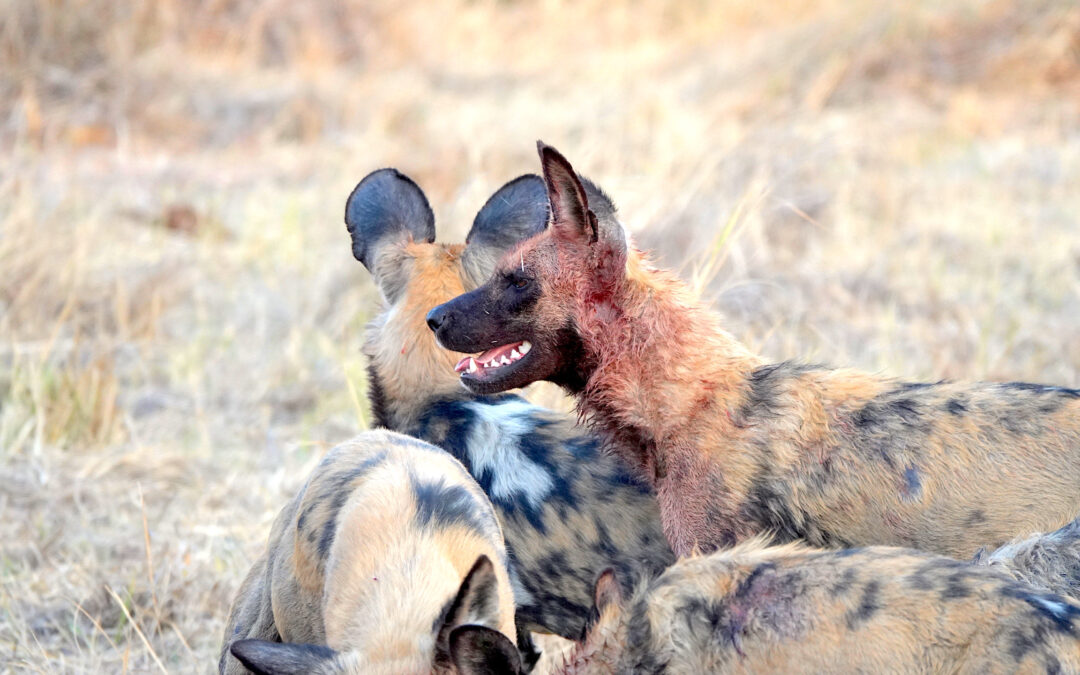
Sep 20, 2019 | Adventure Safari, Animals of Botswana, Brave Africa Safari, Game Drive, Most Popular Blogs
We just completed Brave Africa’s very first full safari, and it was incredible! When you imagine the once-in-a-lifetime experiences you’ll have on a Botswana animal safari, we hit every single one.
It was breathtaking.
If you’re looking for the best animal sightings in Botswana, we had them! (more…)
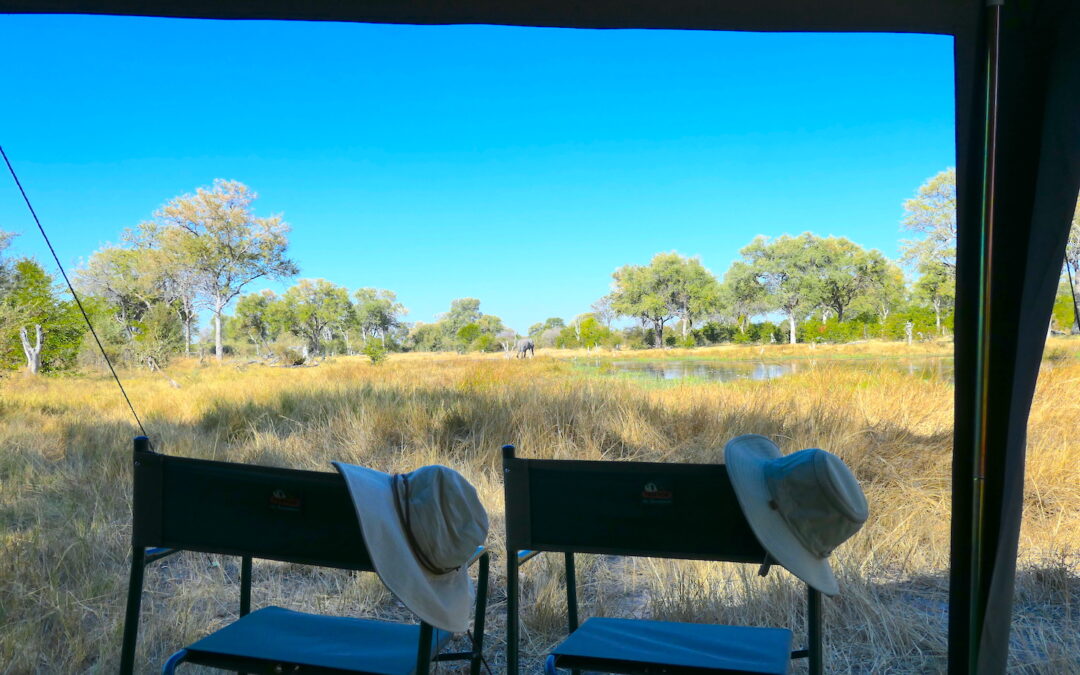
Aug 3, 2019 | Adventure Safari, Brave Africa Safari, Safari Tips
If you’re getting ready to plan your first safari in Botswana, you’re probably concerned about the cost. You’ve heard tales about how Botswana is the most expensive location to safari even as it’s also considered the best.
So, what can you expect when it comes to the cost of a safari in Botswana? Is it only affordable for the wealthy?
We won’t lie and say that going on safari is cheap, but it’s not as expensive as you might think. By choosing the right flights, time of year, and safari experience, you can still have the experience of a lifetime at a price that’s less than you might expect.
Cost of Botswana Safari International Flights
When you first start planning your trip to Africa, you’re probably concerned about the price of plane tickets. After all, it’s expensive to fly short flights. How much more costly is a flight to Botswana?
The U.S. to South Africa — USD $800 – $1400 Round-Trip
If you’re coming from the U.S., there are many options for getting to Johannesburg, South Africa. It all depends on where you’re coming from. In most cases, you’re going to want to make your way to the East Coast.
JFK New York is a popular airport, and right now, flights on Kenya Airways and through Nairobi are just $886 for a round-trip. Going through Los Angeles, you can expect to pay only $1,033 on Qatar Airways through Doha.


Europe to South Africa — USD $663 – $950 Round-Trip
If you’re traveling from Europe, you can expect flights to be a little bit cheaper. From Frankfurt, a flight on Ethiopian Air is just $663 round trip, and on Lufthansa, it’s $916.

Australia to South Africa — USD $1150 – $1500 Round-Trip
From Australia to South Africa, you can expect similar prices as the U.S. Nonstop flights start around $1250 on Qantas Airways.

Flights to Maun — USD $200 – $350 One-Way
Once you make it to South Africa, you then have to take another short international flight—two hours—to get to Maun, Botswana. While Air Botswana is typically your most affordable option, we recommend flying South African Airways for a better guarantee of your flight arriving on time.
Here’s what you can expect to pay to fly to and from Maun, Botswana:
- Johannesburg to Maun: USD $200 – $300 one-way
- Cape Town to Maun: USD $275 – $350 one-way
Flights to Victoria Falls —USD $250 – $319 One-Way
If you decide to visit Victoria Falls before or after your safari, you’ll need flights to or from Victoria Falls:
- Johannesburg to Victoria Falls: USD $250 – $319 one-way
Bush Flights — USD $430 – $600 Round-Trip
Going on safari in Botswana is unique in Africa in terms of travel. While in South Africa, Kenya, and Tanzania, it’s common to drive to your safari camp, in Botswana, that’s not the case.
The remoteness of Botswana’s safari destinations means that driving isn’t a choice for most travelers. It would take up too much time and require a four-wheel-drive vehicle. That’s why bush flights are the popular choice for travelers and safari camps alike.
The good news is that there are many options for chartered bush flights, including:
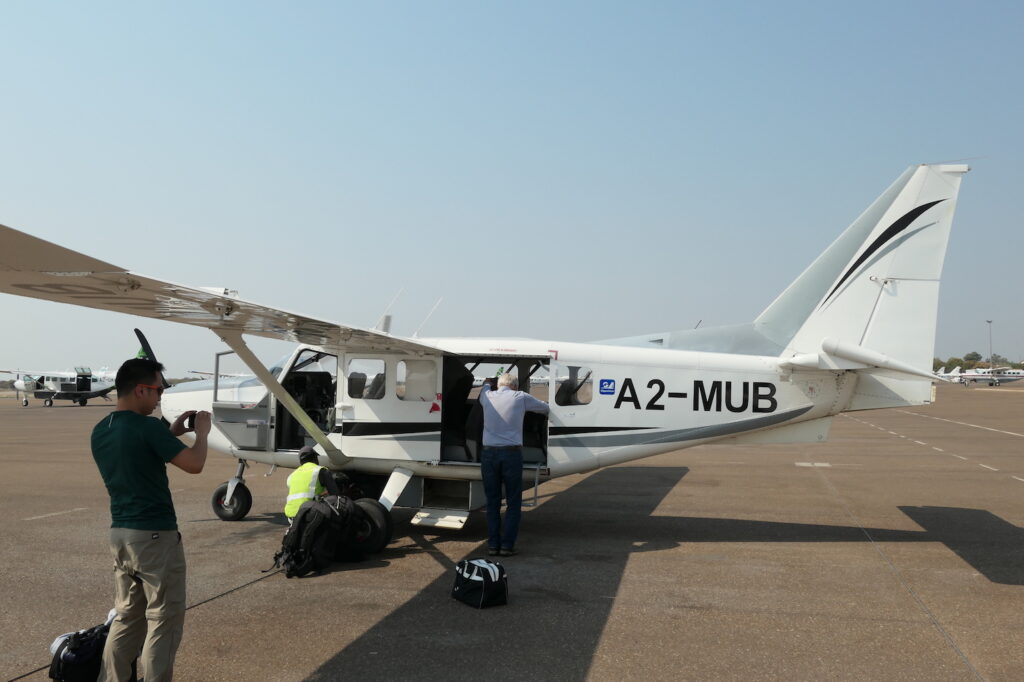
So, what’s the exact cost of Botswana safari bush flights? Your travel agent will, most likely, include it in the total price of your safari. But, if you decide to book your own bush flights in Botswana, we talked to Mack Air to get their 2019/2020 rates.
Maun is your most likely departure point. It’s the most accessible destination to fly to from Johannesburg or Cape Town, which is most likely where you’ll enter Africa for your international flight. The good news is that since Maun is such a popular starting off point, prices are relatively affordable.
- Maun to Xakanaxa: USD $215 per person
- Maun to Khwai: USD $215 per person
- Maun to Savuti: USD $217 per person
However, if you’re coming from or heading to Victoria Falls before or after your safari, then you might use the Kasane airport instead. Due to the airport’s location as well as its less frequent use, flights to and from Kasane are slightly more expensive.
- Kasane to Xakanaxa: USD $372 per person
- Kasane to Khwai: USD $372 per person
- Kasane to Savuti: USD $357 per person

The Cost of a Safari in Botswana
After paying for flights, the only thing you have to worry about is the cost of your safari in Botswana.
The great news about a safari is that it’s all-inclusive. There’s no paying for a hotel and then paying for your food and activities separately. After just a few days, you might not realize how quickly it all adds up.
According to recent surveys of Americans on vacation, each day, on average, you can expect to pay:
- $258 — for a hotel room in a large city such as New York City
- $59 — for a car rental
- $50 — for food
- $100 — all-day activity/tour
That’s a total of $467 per day + $159 per day for every additional person. So, for two people, that equates to $608 per day on average for an international trip. That’s $6,080 for 10-days for a couple.
Now, that price can increase or decrease significantly depending on where you’re heading for a vacation. The more remote the destination or popular the city, the more you can expect to pay.
A safari with Brave Africa isn’t that much more expensive. Our per-person price includes:
- Accommodations
- All meals, snacks, and house beverages (including unlimited alcoholic drinks)
- Laundry
- Road transfers from the nearest airstrip and between our camps
- National park fees
- Emergency medical evacuation insurance
- All-day game drives and professional guiding
For all of that, you can pay as little as $880 per couple per day for a ten-day/nine-night safari in Botswana. That’s barely $270 more per day for a trip of a lifetime.


Total Cost of a Botswana Safari
So, when you add everything up, how much does it cost to go on safari in Botswana for a couple? Let’s add it up.
- International Flights: $2000 per couple
- Maun Flights: $1000 per couple
- Bush Flights: $1000 per couple
- 10-Day Safari: $10,000 per couple (shoulder rack)
Total Cost of a 10-Day Safari in Botswana for Two: USD $14,000
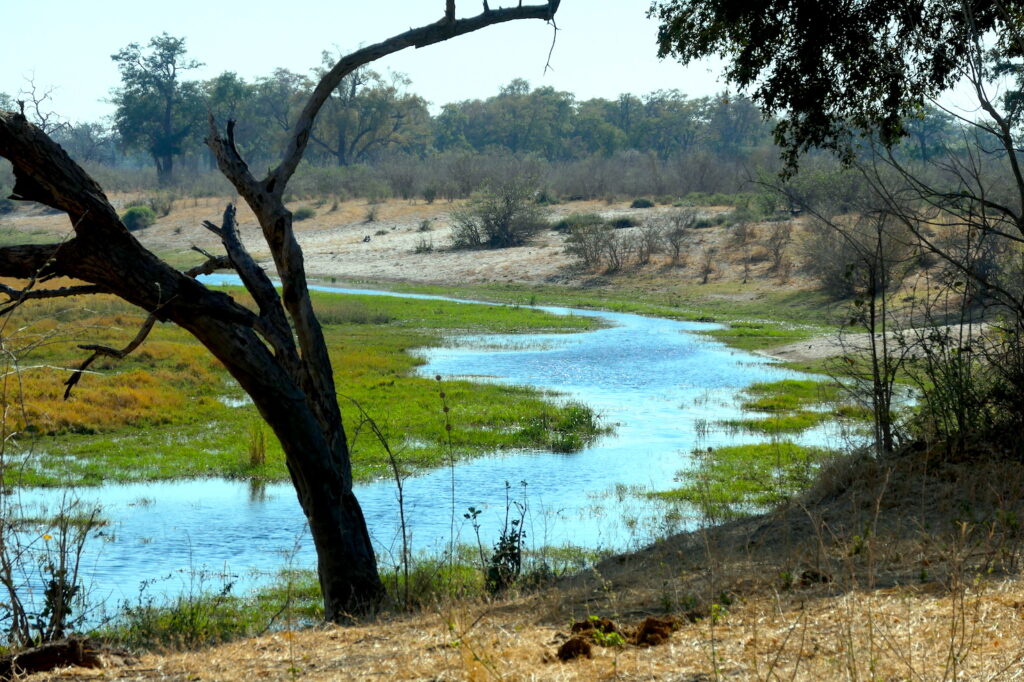
And while that might seem expensive, let’s compare it to a trip to Disney World. This is a fairly decent comparison because you pay a daily fee for all-day activities, aka park tickets and hotels are at a premium on property. We planned a 9-night/10-day vacation and chose the average prices for comparison.
- Hotel: $350/night — $3,150 total
- 10-Day Tickets: $1100 per couple
- 10-Day Dining Plan: $1300 per couple
- International Flights: $2000 per couple
Total Cost of a 10-Day Trip to Disney World in Orlando, FL: USD $7,550
So, would you rather pay half as much and go to Disney World like everyone else or pay a little more and go on a trip that will change your life?
And if you’d like to save some money on flights, we’re writing a blog in a few weeks about using just 80,000 points per person for a round trip flight to South Africa. That’s a $2000 savings! So stay tuned!

































